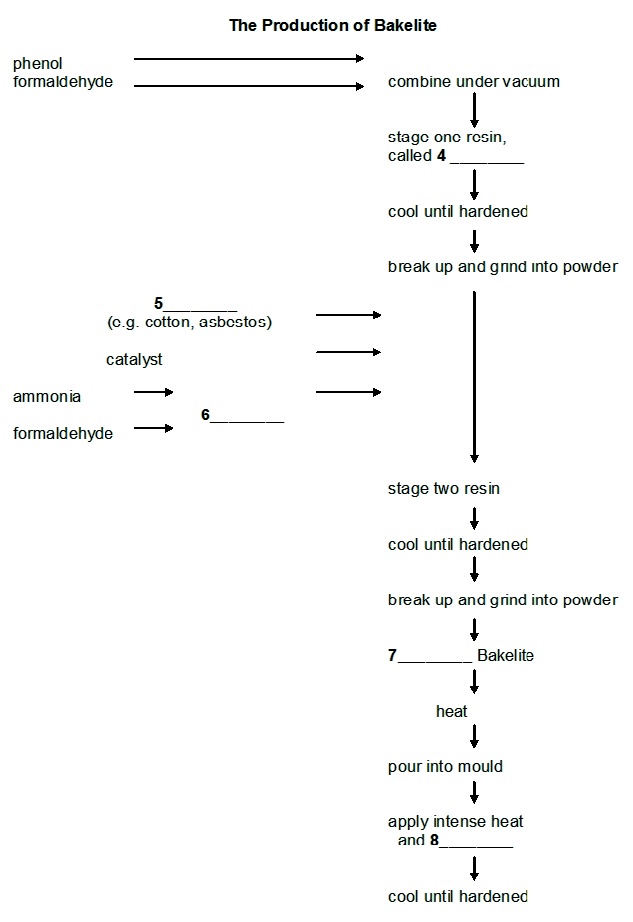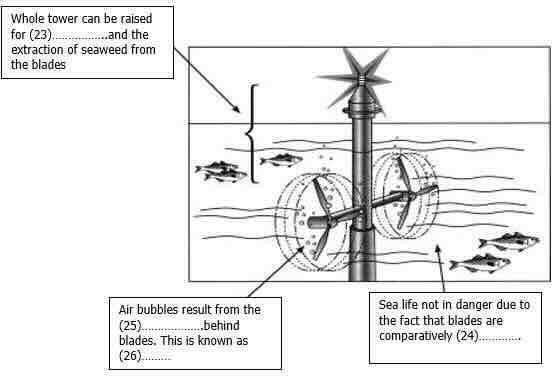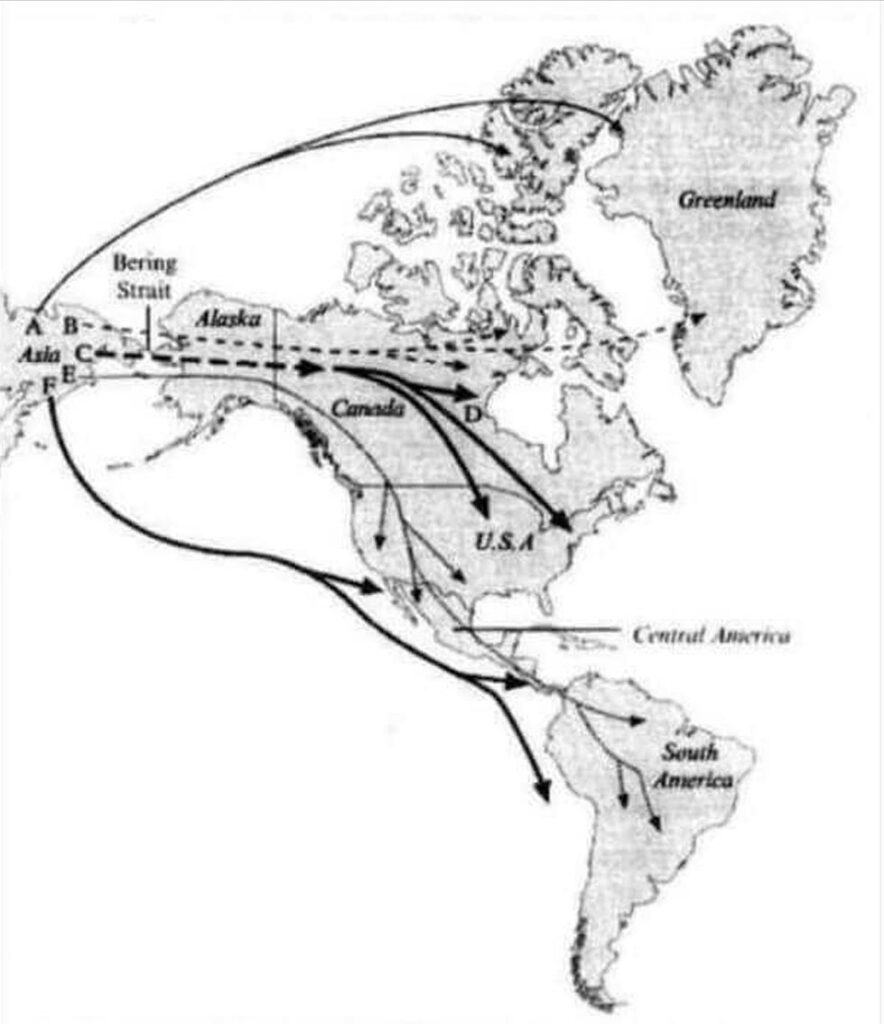Reading passage 1
In 1907, Leo Hendrick Baekeland, a Belgian scientist working in New York, discovered and patented a revolutionary new synthetic material. His invention, which he named ‘Bakelite’, was of enormous technological importance, and effectively launched the modern plastics industry.
The term ‘plastic’ comes from the Greek plassein, meaning ‘to mould’. Some plastics are derived from natural sources, some are semi-synthetic (the result of chemical action on a natural substance), and some are entirely synthetic, that is, chemically engineered from the constituents of coal or oil. Some are ‘thermoplastic’, which means that, like candlewax, they melt when heated and can then be reshaped.
Others are ‘thermosetting’: like eggs, they cannot revert to their original viscous state, and their shape is thus fixed forever. Bakelite had the distinction of being the first totally synthetic thermosetting plastic.
The history of today’s plastics begins with the discovery of a series of semi-synthetic thermoplastic materials in the mid-nineteenth century. The impetus behind the development of these early plastics was generated by a number of factors – immense technological progress in the domain of chemistry, coupled with wider cultural changes, and the pragmatic need to find acceptable substitutes for dwindling supplies of ‘luxury’ materials such as tortoiseshell and ivory.
Baekeland’s interest in plastics began in 1885 when, as a young chemistry student in Belgium, he embarked on research into phenolic resins, the group of sticky substances produced when phenol (carbolic acid) combines with an aldehyde (a volatile fluid similar to alcohol). He soon abandoned the subject, however, only returning to it some years later. By 1905 he was a wealthy New Yorker, having recently made his fortune with the invention of a new photographic paper. While Baekeland had been busily amassing dollars, some advances had been made in the development of plastics. The years 1899 and 1900 had seen the patenting of the first semi-synthetic thermosetting material that could be manufactured on an industrial scale. In purely scientific terms, Baekeland’s major contribution to the field is not so much the actual discovery of the material to which he gave his name, but rather the method by which a reaction between phenol and formaldehyde could be controlled, thus making possible its preparation on a commercial basis. On 13 July 1907, Baekeland took out his famous patent describing this preparation, the essential features of which are still in use today.
The original patent outlined a three-stage process, in which phenol and formaldehyde (from wood or coal) were initially combined under vacuum inside a large egg-shaped kettle. The result was a resin known as Novalak, which became soluble and malleable when heated. The resin was allowed to cool in shallow trays until it hardened, and then broken up and ground into powder. Other substances were then introduced: including fillers, such as woodflour, asbestos or cotton, which increase strength and moisture resistance, catalysts (substances to speed up the reaction between two chemicals without joining to either) and hexa, a compound of ammonia and formaldehyde which supplied the additional formaldehyde necessary to form a thermosetting resin. This resin was then left to cool and harden, and ground up a second time. The resulting granular powder was raw Bakelite, ready to be made into a vast range of manufactured objects. In the last stage, the heated Bakelite was poured into a hollow mould of the required shape and subjected to extreme heat and pressure; thereby ‘setting’ its form for life.
The design of Bakelite objects, everything from earrings to television sets, was governed to a large extent by the technical requirements of the moulding process. The object could not be designed so that it was locked into the mould and therefore difficult to extract. A common general rule was that objects should taper towards the deepest part of the mould, and if necessary the product was moulded in separate pieces. Moulds had to be carefully designed so that the molten Bakelite would flow evenly and completely into the mould. Sharp corners proved impractical and were thus avoided, giving rise to the smooth, ‘streamlined’ style popular in the 1930s. The thickness of the walls of the mould was also crucial: thick walls took longer to cool and harden, a factor which had to be considered by the designer in order to make the most efficient use of machines.
Baekeland’s invention, although treated with disdain in its early years, went on to enjoy an unparalleled popularity which lasted throughout the first half of the twentieth century. It became the wonder product of the new world of industrial expansion — ‘the material of a thousand uses’. Being both non- porous and heat-resistant, Bakelite kitchen goods were promoted as being germ-free and sterilisable.
Electrical manufacturers seized on its insulating: properties, and consumers everywhere relished its dazzling array of shades, delighted that they were now, at last, no longer restricted to the wood tones and drab browns of the pre-plastic era. It then fell from favour again during the 1950s, and was despised and destroyed in vast quantities. Recently, however, it has been experiencing something of a renaissance, with renewed demand for original Bakelite objects in the collectors’ marketplace, and museums, societies and dedicated individuals once again appreciating the style and originality of this innovative material.
Questions 1-3. Complete the summary. Choose ONE WORD ONLY from the passage for each answer. Write your answers in boxes 1-3 on your answer sheet.
Some plastics behave in a similar way to 1……………….. in that they melt under heat and can be moulded into new forms. Bakelite was unique because it was the first material to be both entirely 2……………….. in origin and thermosetting.
There were several reasons for the research into plastics in the nineteenth century, among them the great advances that had been made in the field of 3……………….. and the search for alternatives to natural resources like ivory.
Questions 4-8. Complete the flow-chart. Choose ONE WORD ONLY from the passage for each answer.Write your answers in boxes 4-8 on your answer sheet.

Questions 9-10. Write your answers in boxes 9 and 10 on your answer sheet. Your answers may be given in either order.
Which TWO of the following factors influencing the design of Bakelite objects are mentioned in the text?
A the function which the object would serve
B the ease with which the resin could fill the mould
C the facility with which the object could be removed from the mould
D the limitations of the materials used to manufacture the mould
E the fashionable styles of the period
Questions 11-13. Do the following statements agree with the information given in Reading Passage 1? In for questions 11-13, write
TRUE if the statement agrees with the information
FALSE if the statement contradicts the information
NOT GIVEN if there is no information on this statement
11 Modern-day plastic preparation is based on the same principles as that patented in 1907.
12 Bakelite was immediately welcomed as a practical and versatile material.
13 Bakelite was only available in a limited range of colours
Reading passage 2. What’s so funny?
John McCrone reviews recent research on humour.
The joke comes over the headphones: ‘Which side of a dog has the most hair? The left.’ No, not funny. Try again. ‘Which side of a dog has the most hair? The outside.’ Hah! The punchline is silly yet fitting, tempting a smile, even a laugh. Laughter has always struck people as deeply mysterious, perhaps pointless. The writer Arthur Koestler dubbed it the luxury reflex: ‘unique in that it serves no apparent biological purpose’.
Theories about humour have an ancient pedigree. Plato expressed the idea that humour is simply a delighted feeling of superiority over others. Kant and Freud felt that joke-telling relies on building up a psychic tension which is safely punctured by the ludicrousness of the punchline. But most modern humour theorists have settled on some version of Aristotle’s belief that jokes are based on a reaction to or resolution of incongruity, when the punchline is either a nonsense or, though appearing silly, has a clever second meaning.
Graeme Ritchie, a computational linguist in Edinburgh, studies the linguistic structure of jokes in order to understand not only humour but language understanding and reasoning in machines. He says that while there is no single format for jokes, many revolve around a sudden and surprising conceptual shift. A comedian will present a situation followed by an unexpected interpretation that is also apt. So, even if a punchline sounds silly, the listener can see there is a clever semantic fit and that sudden mental ‘Aha!’ is the buzz that makes us laugh. Viewed from this angle, humour is just a form of creative insight, a sudden leap to a new perspective.
However, there is another type of laughter, the laughter of social appeasement and it is important to understand this too. Play is a crucial part of development in most young mammals. Rats produce ultrasonic squeaks to prevent their scuffles turning nasty. Chimpanzees have a ‘play-face’ – a gaping expression accompanied by a panting ‘ah, ah’ noise. In humans, these signals have mutated into smiles and laughs. Researchers believe social situations, rather than cognitive events such as jokes, trigger these instinctual markers of play or appeasement.
Both social and cognitive types of laughter tap into the same expressive machinery in our brains, the emotion and motor circuits that produce smiles and excited vocalisations. However, if cognitive laughter is the product of more general thought processes, it should result from more expansive brain activity.
Psychologist Vinod Goel investigated humour using the new technique of ‘single event’ functional magnetic resonance imaging (FMRI). An MRI scanner uses magnetic fields and radio waves to track the changes in oxygenated blood that accompany mental activity. Until recently, MRI scanners needed several minutes of activity and so could not be used to track rapid thought processes such as comprehending a joke. New developments now allow half-second ‘snapshots’ of all sorts of reasoning and problem-solving activities.
Although Goel felt being inside a brain scanner was hardly the ideal place for appreciating a joke, he found evidence that understanding a joke involves a widespread mental shift. His scans showed that at the beginning of a joke the listener’ prefrontal cortex lit up, particularly the right prefrontal believed to be critical for problem solving. But there was also activity in the temporal lobes at the side of the head (consistent with attempts to rouse stored knowledge) and in many other brain areas. Then when the punchline arrived, a new area sprang to life – the orbital prefrontal cortex. This patch of brain tucked behind the orbits of the eyes is associated with evaluating information.
Making a rapid emotional assessment of the events of the moment is an extremely demanding job for the brain, animal or human. Energy and arousal levels may need to be retuned in the blink of an eye.These abrupt changes will produce either positive or negative feelings. The orbital cortex, the regionthat becomes active in Goel’s experiment, seems the best candidate for the site that feeds such feelings into higher-level thought processes, with its close connections to the brain’s sub-cortical arousal apparatus and centres of metabolic control.
All warm-blooded animals make constant tiny adjustments in arousal in response to external events, but humans, who have developed a much more complicated internal life as a result of language, respond emotionally not only to their surroundings, but to their own thoughts. Whenever a sought-for answer snaps into place, there is a shudder of pleased recognition. Creative discovery being pleasurable, humans have learned to find ways of milking this natural response. The fact that jokes tap into our general evaluative machinery explains why the line between funny and disgusting, or funny andfrightening, can be so fine. Whether a joke gives pleasure or pain depends on a person’s outlook.Humour may be a luxury, but the mechanism behind it is no evolutionary accident. As Peter Derks, a psychologist at William and Mary College in Virginia, says: ‘I like to think of humour as the distorted mirror of the mind. It’s creative, perceptual, analytical and lingual. If we can figure out how the mind processes humour, then we’ll have a pretty good handle on how it works in general.
Questions 14-20. Do the following statements agree with the information given in Reading Passage 2? For questions 14-20, write
TRUE if the statement agrees with the information
FALSE if the statement contradicts the information
NOT GIVEN if there is no information on this statement
14 Arthur Koestler considered laughter biologically important in several ways.
15 Plato believed humour to be a sign of above-average intelligence.
16 Kant believed that a successful joke involves the controlled release of nervous energy.
17 Current thinking on humour has largely ignored Aristotle’s view on the subject.
18 Graeme Ritchie’s work links jokes to artificial intelligence.
19 Most comedians use personal situations as a source of humour.
20 Chimpanzees make particular noises when they are playing.
Questions 21-23. The diagram below shows the areas of the brain activated by jokes.
Label the diagram. Choose NO MORE THAN TWO WORDS from the passage for each answer.

Questions 24-27Complete each sentence with the correct ending A-G below. Write the correct letter A-G next to questions 24-27.
24 One of the brain’s most difficult tasks is to
25 Because of the language they have developed, humans
26 Individual responses to humour
27 Peter Derks believes that humour
A react to their own thoughts.
B helped create language in humans.
C respond instantly to whatever is happening.
D may provide valuable information about the operation of the brain.
E cope with difficult situations.
F relate to a person’s subjective views.
G led our ancestors to smile and then laugh.
Reading passage 3.
The Birth of Scientific English
World science is dominated today by a small number of languages, including Japanese, German and French, but it is English which is probably the most popular global language of science. This is not just because of the importance of English-speaking countries such as the USA in scientific research; the scientists of many non-English-speaking countries find that they need to write their research papers in English to reach a wide international audience. Given the prominence of scientific English today, it may seem surprising that no one really knew how to write science in English before the 17th century. Before that, Latin was regarded as the lingua franca for European intellectuals.
The European Renaissance (circa 14th-16th century) is sometimes called the ‘revival of learning’, a time of renewed interest in the ‘lost knowledge’ of classical times. At the same time, however, scholars also began to test and extend this knowledge. The emergent nation states of Europe developed competitive interests in world exploration and the development of trade. Such expansion, which was to take the English language west to America and east to India, was supported by scientific developments such as the discovery of magnetism (and hence the invention of the compass), improvements in cartography and – perhaps the most important scientific revolution of them all – the new theories of astronomy and the movement of the Earth in relation to the planets and stars, developed by Copernicus (1473-1543).
England was one of the first countries where scientists adopted and publicised Copernican ideas with enthusiasm. Some of these scholars, including two with interests in language – John Wall’s and John Wilkins – helped Found the Royal Society in 1660 in order to promote empirical scientific research.
Across Europe similar academies and societies arose, creating new national traditions of science. In the initial stages of the scientific revolution, most publications in the national languages were popular works, encyclopaedias, educational textbooks and translations.
Original science was not done in English until the second half of the 17th century. For example, Newton published his mathematical treatise, known as the Principia, in Latin, but published his later work on the properties of light – Optics – in English.
There were several reasons why original science continued to be written in Latin. The first was simply a matter of audience. Latin was suitable for an international audience of scholars, whereas English reached a socially wider, but more local, audience. Hence, popular science was written in English.
A second reason for writing in Latin may, perversely, have been a concern for secrecy. Open publication had dangers in putting into the public domain preliminary ideas which had not yet been fully exploited by their ‘author’ . This growing concern about intellectual property rights was a feature of the period – it reflected both the humanist notion of the individual, rational scientist who invents and discovers through private intellectual labour, and the growing connection between original science and commercial exploitation. There was something of a social distinction between ‘scholars and gentlemen’ who understood Latin, and men of trade who lacked a classical education. And in the mid-17th century it was common practice for mathematicians to keep their discoveries and proofs secret, by writing them in cipher, in obscure languages, or in private messages deposited in a sealed box with the Royal Society.
Some scientists might have felt more comfortable with Latin precisely because its audience, though international, was socially restricted. Doctors clung the most keenly to Latin as an ‘insider language’.
A third reason why the writing of original science in English was delayed may have been to do with the linguistic inadequacy of English in the early modern period. English was not well equipped to deal with scientific argument. First, it lacked the necessary technical vocabulary. Second, it lacked the grammatical resources required to represent the world in an objective and impersonal way, and to discuss the relations, such as cause and effect, that might hold between complex and hypothetical entities.
Fortunately, several members of the Royal Society possessed an interest in language and became engaged in various linguistic projects. Although a proposal in 1664 to establish a committee for improving the English language came to little, the society’s members did a great deal to foster the publication of science in English and to encourage the development of a suitable writing style. Many members of the Royal Society also published monographs in English. One of the first was by Robert Hooke, the society’s first curator of experiments, who described his experiments with microscopes in Micrographia (1665). This work is largely narrative in style, based on a transcript of oral demonstrations and lectures.
In 1665 a new scientific journal, Philosophical Transactions, was inaugurated. Perhaps the first international English-language scientific journal, it encouraged a new genre of scientific writing, that of short, focused accounts of particular experiments.
The 17th century was thus a formative period in the establishment of scientific English. In the following century much of this momentum was lost as German established itself as the leading European language of science. It is estimated that by the end of the 18th century 401 German scientific journals had been established as opposed to 96 in France and 50 in England. However, in the 19th century scientific English again enjoyed substantial lexical growth as the industrial revolution created the need for new technical vocabulary, and new, specialised, professional societies were instituted to promote and publish in the new disciplines.
Questions 28-34. Complete the summary.
For answers to questions 28-34 choose NO MORE THAN TWO WORDS from the passage.
In Europe modern science emerged at the same time as the nation state. At first, the scientific language of choice remained 28……………………….. It allowed scientists to communicate with other socially privileged thinkers while protecting their work from unwanted exploitation. Sometimes the desire to protect ideas seems to have been stronger than the desire to communicate them, particularly in the case of mathematicians and 29………………………. In Britain, moreover, scientists worried that English had neither the 30………………………. nor the 31………………………. to express their ideas. This situation only changed after 1660 when scientists associated with the 32 ………………………. set about developing English. An early scientific journal fostered a new kind of writing based on short descriptions of specific experiments. Although English was then overtaken by 33………………………. , it developed again in the 19th century as a direct result of the 34………………………..
Questions 35-37. Do the following statements agree with the information given in Reading Passage 3?For questions 35- 37, write
YES if the statement agrees with the writer’s claims
NO if the statement contradicts the writer’s claims
NOT GIVEN if there is impossible to say what the writer thinks about this.
35 There was strong competition between scientists in Renaissance Europe.
36 The most important scientific development of the Renaissance period was the discovery of magnetism.
37 In 17th century Britain, leading thinkers combined their interest in science with an interest in how to express ideas.
Questions 38-40. Complete the table. Choose NO MORE THAN TWO WORDS from the passage for each answer
| Science written in the first half of the 17th century | ||
| Language used | Latin | English |
| Type of science | Original | 38 ……………………. |
| Examples | 39 ……………………. | Encyclopedias |
| Target audience | International scholars | 40……………………. but socially wider |
Do you need printed IELTS/ OET practice material? Place your order today. Available now for just Rs: 1,100 (including shipping all across India) Contact us at our WhatsApp number: +91 9886926773 to place your order. (Free for LTC students)

We hope this information has been valuable to you. If so, please consider a monetary donation to Lifestyle Training Centre via UPI. Your support is greatly appreciated.

Would you like to undergo training for OET, PTE, IELTS, Duolingo, Phonetics, or Spoken English with us? Kindly contact us now!
📱 Call/WhatsApp/Text: +91 9886926773
📧 Email: [email protected]
Visit us in person by following the directions on Google Maps. We look forward to welcoming you to the Lifestyle Training Centre.
Follow Lifestyle Training Centre on social media:
Thank you very much!
Would you like to download a copy of the practice test? Please click on the download button below:






